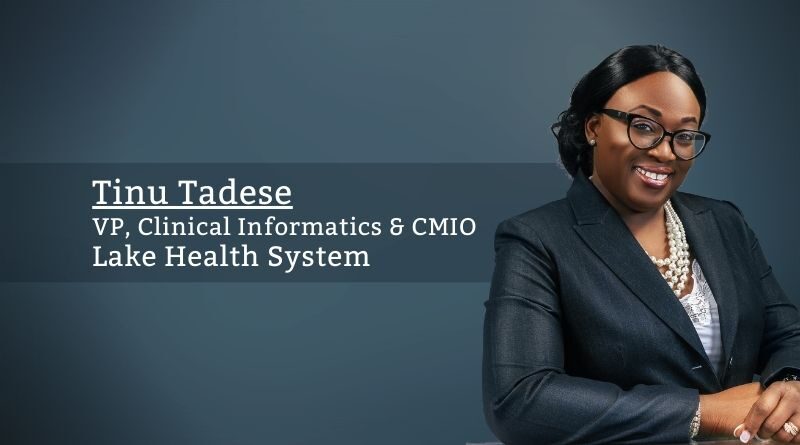Mastering the Use of Data, Technology, and Process to Enhance Your Health System’s Bottom Line
By Tinu Tadese, MD FACHE, VP, Clinical Informatics & CMIO, Lake Health System
I was privileged to get into Health IT right around when the Meaningful Use initiative was the Healthcare industry buzz. The whole point of the initiative was the use of certified EHR technology in a meaningful manner.
I stayed the course, and I have been on this journey every step of the way, waiting to see with bated breath how this will all turn out. Well, I am still in the trenches, and excited to be at the point in which I see that almost every health system in the United States has accumulated an incredible amount of data. Now the question is, what do we do with this data?
In addition to my passion for all things EHR, I have a great interest in the financial outcomes of our health systems. As a Chief Medical Information Officer, I sit in an enviable position in the whole sausage-making process – in a seat where I see the data collected, processed, and turned around to become meaningful dollars to keep our health system afloat so we can continue to provide care for the millions of patients we see every year.
Every health system that hopes to survive and keep its doors open to continue to provide care must, of necessity, master the use of technology and the massive treasure trove of data it continues to accumulate.
Although reimbursement of health systems was not one of the five pillars of the Meaningful Use initiative, it has become a crucial byproduct of the whole experiment.
Every health system that hopes to survive and keep its doors open to continue to provide care must, of necessity, master the use of technology and the massive treasure trove of data it continues to accumulate.
Understanding Health System Wealth
I use the term Health System Wealth in my mind. That’s how I see data. I see it as a treasure trove. A chest full of gold and precious stones are hidden away from the average eyes. I personally have a quest to find it, master it and turn it around.
So, in my mind, “X” marks the spot. The “X” is in our Data Warehouses – tucked away in a basement or somewhere in an EHR vendor’s “Cloud.” We need to mine these.
But let’s take a practical look at the data closest to us and the processes surrounding the collection of those data. Here are a few gold nuggets.
Paying attention to data collection
Data Capture: What, When, and Where
As a physician, I have found over the years that due to the nature of our training, reimbursement of our hospital is often not top of mind when we are seeing a patient. For instance, the Emergency Room (ER) physician. In that highly pressured environment, all she thinks of is the immediate care of the patient’s often life-threatening issues – and rightly so. However, when it comes to reimbursements, all the payer is thinking of is what was documented at the time of the encounter. Did she order the EKG the nurse performed? If she didn’t, that EKG, as crucial as it was when done, will likely go unreimbursed. Did she describe in detail the length and depth of the laceration she sutured, i.e., is this a simple laceration repair or an intermediate layered closure? This simple omission is many times a difference of hundreds of dollars in reimbursement per procedure. And when you think of how many laceration repairs are performed in our ERs, you can start to see how many thousands, even millions of dollars, are lost to our health systems every quarter, every year.
Detailed Provider and Clinician Documentation is Gold
Comorbidities (CC) and Major Comorbidities (MCC). As we all know, every line documented in your EHR has the potential to turn into (or take away potential) reimbursed dollars. The utmost importance of documenting Comorbidities (CC) and Major Comorbidities (MCC) cannot be overemphasized. This has a direct near-term and long-term impact on at least three things.
- Immediate reimbursement for that particular admission
- The Case Mix Index – which translates into immediate dollars for your health system
- Your quality reporting to CMS has long term implications for reimbursement to your health system
To understand and maximize this, is to realize literarily millions of dollars per year for the health system. For this reason, many health systems now have not only a Clinical Documentation Improvement (CDI) team they have also hired Physician Advisors to ensure that CCs and MCCs are accurately captured.
The People, Process, Technology Gold
The Admission Process Gold.
In my world of Clinical Informatics, the mantra is People, Process, and Technology. Most payers require that the hospital checks in with them to ensure that the patient meets the Medical Necessity requirements. To do this, the payers require that they see the documentation that justifies this patient admission within a certain timeline – 24 or 48 hours. This usually is in the form of a History and Physical (H & P) document. As simple as this seems, many hospitals struggle with getting many of their Providers (often heavy admitters) to document H & Ps to meet that timeline. This is so because admission orders can easily be called in verbally or even entered electronically. As we all know, an admission that is not pre-approved many times will go unreimbursed – again, a loss of millions of dollars in reimbursement.
How to Start Gold Mining
So, where do we start? I suggest starting our gold mining in 3 areas. These areas, I found, are the greatest areas of revenue loss and could, with data capture and process improvements, cause a quick and appreciable rebound in a health system’s bottom line.
- The Emergency Department.
- The Admission Processes.
- Provider Documentation right through the health system – outpatient and inpatient areas.
My recommendation is to do this through a systematic Process Improvement initiative focused on the health system’s bottom line. For example, targeted Lean events that involve the key players: Revenue Cycle, Quality, HIM, Clinical Informatics, and the leaders of the clinical areas.



